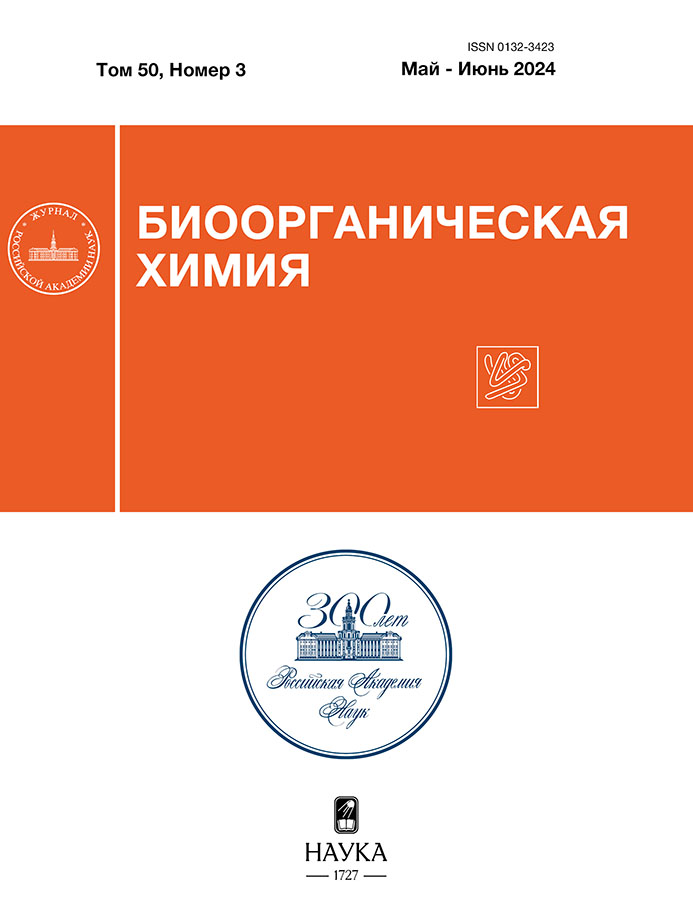Tree-dimensional structure of the fluorescent complex of bacterial lipocalin triple mutant with chromophore – DiB3-F53L/F74L/L129M
- Autores: Rossokhin A.V.1,2, Goryacheva E.A.1, Artemyev I.V.1, Arhipova S.F.1, Gilvanov A.R.1, Pletneva N.V.1, Pletnev V.Z.1
-
Afiliações:
- Shemyakin–Ovchinnikov Institute of Bioorganic Chemistry RAS
- Research Center of Neurology
- Edição: Volume 50, Nº 3 (2024)
- Páginas: 345-350
- Seção: ПИСЬМА РЕДАКТОРУ
- URL: https://cardiosomatics.ru/0132-3423/article/view/670936
- DOI: https://doi.org/10.31857/S0132342324030146
- EDN: https://elibrary.ru/NXOXAI
- ID: 670936
Citar
Texto integral
Resumo
The three dimensional structure of DiB3-F53L/F74L/L129M – a triple mutant of the fluorescent non-covalent complex of a genetically engineered variant of the bacterial protein lipocalin Blc with the synthetic GFP-like chromophore M739, has been studied by molecular dynamics methods. It was found that the chromophore binding site in the complex is similar to DiB1 and differs from the alternative site in DiB3. The complex is characterized by increased fluorescence brightness compared to those with other genetically engineered variants of lipocalin, which makes it one of the promising markers of biological objects in cell biology.
Palavras-chave
Texto integral
Sobre autores
A. Rossokhin
Shemyakin–Ovchinnikov Institute of Bioorganic Chemistry RAS; Research Center of Neurology
Email: goryacheva@ibch.ru
Научный центр неврологии, Институт мозга
Rússia, ul. Miklukho-Maklaya 16/10, Moscow, 117997; per. Obuha 5, Moscow, 105064E. Goryacheva
Shemyakin–Ovchinnikov Institute of Bioorganic Chemistry RAS
Autor responsável pela correspondência
Email: goryacheva@ibch.ru
Rússia, ul. Miklukho-Maklaya 16/10, Moscow, 117997
I. Artemyev
Shemyakin–Ovchinnikov Institute of Bioorganic Chemistry RAS
Email: goryacheva@ibch.ru
Rússia, ul. Miklukho-Maklaya 16/10, Moscow, 117997
S. Arhipova
Shemyakin–Ovchinnikov Institute of Bioorganic Chemistry RAS
Email: goryacheva@ibch.ru
Rússia, ul. Miklukho-Maklaya 16/10, Moscow, 117997
A. Gilvanov
Shemyakin–Ovchinnikov Institute of Bioorganic Chemistry RAS
Email: goryacheva@ibch.ru
Rússia, ul. Miklukho-Maklaya 16/10, Moscow, 117997
N. Pletneva
Shemyakin–Ovchinnikov Institute of Bioorganic Chemistry RAS
Email: goryacheva@ibch.ru
Rússia, ul. Miklukho-Maklaya 16/10, Moscow, 117997
V. Pletnev
Shemyakin–Ovchinnikov Institute of Bioorganic Chemistry RAS
Email: goryacheva@ibch.ru
Rússia, ul. Miklukho-Maklaya 16/10, Moscow, 117997
Bibliografia
- Rothe C., Skerra A. // BioDrugs. 2018. V. 32. P. 233– 243. https://doi.org/10.1007/s40259-018-0278-1
- Campanacci V., Bishop R.E., Blangy S., Tegoni M., Cambillau C. // FEBS Lett. 2006. V. 580. P. 877−883. https://doi.org/10.1016/j.febslet.2006.07.086
- Muslinkina L., Gavrikov A.S., Bozhanova N.G., Mishin A.S., Baranov M.S., Meiler J., Pletneva N.V., Pletnev V.Z., Pletnev S. // ACS Chem. Biol. 2020. V. 15. P. 2456−2465. https://doi.org/10.1021/acschembio.0c00440
- Bozhanova N.G., Mikhail S., Baranov M.S., Klementieva N.V., Gavrikov A.S., Sarkisyan K.S., Yampolsky I.V., Zagaynova E.V., Lukyanov S.A., Konstantin A., Lukyanov K.A., Mishin A.S. // Chem. Sci. 2017. V. 8. Р. 7138–7142. https://doi.org/10.1039/C7SC01628J
- Karplus M., Petsko G.A. // Nature. 1990. V. 347. P. 631–639. https://doi.org/10.1038/347631a0
- Sansom M.S., Adcock C., Smith G.R. // J. Struct. Biol. 1998. V. 121. P. 246–262. https://doi.org/10.1006/jsbi.1997.3950
- Emsley P., Lohkamp B., Scott W.G., Cowtan K. // Acta Crystallogr. D Biol. Crystallogr. 2010. V. 66. P. 486–501. https://doi.org/10.1107/s0907444910007493
- Lee J., Cheng X., Swails J.M., Yeom M.S., Eastman P.K., Lemkul J.A., Wei S., Buckner J., Jeong J.C., Qi Y., Jo S., Pande V.S., Case D.A., Brooks C.L., MacKerell A.D. Jr., Klauda J.B., Im W. // J. Chem. Theor. Comput. 2016. V. 12. P. 405–413. https://doi.org/10.1021/acs.jctc.5b00935
- Essmann U., Perera L., Berkowitz M.L., Darden T., Lee H., Pedersen L.G. // J. Chem. Phys. 1995. V. 103. P. 8577–8593. https://doi.org/10.1063/1.470117
- Darden T., York D., Pedersen L. // J. Chem. Phys. 1993. V. 98. P. 10089–10092. https://doi.org/10.1063/1.464397
- Phillips J.C., Braun R., Wang W., Gumbart J., Tajkhorshid E., Villa E., Chipot C., Skeel R.D., Kale L., Schulten K. // J. Comput. Chem. 2005. V. 26. P. 1781–1802. https://doi.org/10.1002/jcc.20289
- Humphrey W., Dalke A., Schulten K. // J. Mol. Graph. 1996. V. 14. P. 33–38. https://doi.org/10.1016/0263-7855(96)00018-5
Arquivos suplementares















